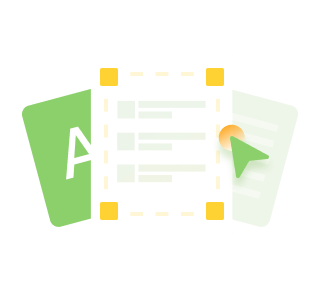Simple Ways to Convert a Picture to Text in Word
In an increasingly digital world, the ability to convert pictures containing text into editable digital documents is invaluable. Whether you're extracting information from a screenshot, digitizing printed documents, or transforming infographics into editable formats, the demand for seamless text conversion is on the rise. The process, often referred to as Optical Character Recognition (OCR), allows users to convert a picture to text in word that can be edited, searched, and stored electronically.
Part 1: Steps to Convert Picture to Text in Word
PDNob Image Translator is designed to tackle these challenges effectively. Utilizing advanced OCR technology, PDNob Image Translator enables accurate and fast convert picture to text in word online into editable formats. Its user-friendly interface simplifies the conversion process, making it accessible for users of all skill levels. Whether you need to convert a single image or batch-process multiple documents, PDNob Image Translator offers a reliable solution that enhances productivity. Convert picture to text in word free using PDNob Image Translator involves several straightforward steps. Below, we provide a detailed guide to help you through the process.
Convert Picture to Text in Word
Picture to Text Converter enables you to accurately convert text from all types of pictures without storing any picture files into the program.
Prepare the Picture: Setting Up Your Document in Word Microsoft Word is widely regarded as the go-to platform for text processing and document creation. However, it does not natively support the conversion of images into text. This limitation necessitates the use of additional tools like PDNob Image Translator for users who need to extract and manipulate text from images efficiently. By integrating PDNob Image Translator with Word, you can maximize the software’s capabilities and streamline your workflow.

Before you begin the conversion process, it's essential to prepare your image for optimal results. Here are some tips for selecting the right picture:
- High Resolution: Ensure the image is of high quality and resolution. Blurry or pixelated images can lead to poor OCR performance and result in misinterpretation of text.
- Simple Background: Choose images with minimal distractions in the background. A clear contrast between the text and its background enhances the OCR tool’s ability to recognize characters accurately.
- Avoid Stylized Fonts: Text in decorative or cursive fonts may be challenging for OCR software to interpret. If possible, use images containing standard fonts for better results.
Saving the Picture from Word to Your Computer
If your image is already embedded in a Word document, start by locating it. Right-click on the picture, and from the context menu, select the "Save as Picture" option. This action allows you to save the image directly to your computer.
When saving the pictures, choose a location that is easy to navigate, such as your desktop or a dedicated folder. Give the image a clear and descriptive name that will help you identify it later. This organizational step is crucial when you have multiple images to convert.

Importing the Picture into PDNob Image Translator. Once you have saved the image, open the PDNob Image Translator application. The interface is designed to be intuitive and straightforward, making it easy for users to navigate through the various options.

To import your saved image, click on the “Import Image” option. This action opens a dialog box, allowing you to browse your files. Navigate to the location where you saved the image, select it, and click “Open.” This will upload the image into PDNob Image Translator.
Adjusting Settings for Optimal ConversionPDNob Image Translator offers several settings to enhance the conversion process. Before initiating the conversion, consider the following:
- Select the Correct Language: Choose the language of the text in the image to improve recognition accuracy. PDNob Image Translator supports multiple languages, so select the one that corresponds to your image.
- Adjust Brightness and Contrast: If the image appears too dark or light, use the brightness and contrast settings to optimize the image quality. Better visibility of the text will lead to improved OCR results.
Converting the Image to Text: Once your image is uploaded and settings are adjusted, it’s time to convert the image to text. Locate the “Convert” button on the interface and click it. PDNob Image Translator will begin the OCR process, transforming the image into editable text in a matter of seconds.

Reviewing and Copying the Extracted Text After the conversion is complete, PDNob Image Translator will display the extracted text. Take a moment to review the text for any errors or formatting issues. While PDNob Image Translator OCR technology is robust, some minor corrections may be necessary, particularly if the original image had complex formatting or unusual fonts.
Once you are satisfied with the text, highlight it and copy it to your clipboard. This text is now ready to be transferred to your Word document.

Exporting Text into Word Click the "Export" button to transform the extracted text into word document directly.
Common Mistakes to Avoid During Conversion
While using PDNob Image Translator simplifies the process, it’s important to be aware of common pitfalls that could hinder the conversion:
- Low-Resolution Images: Always opt for high-resolution images. Low-quality images can lead to inaccuracies in text extraction, requiring more extensive editing afterward.
- Complex Backgrounds or Fonts: Avoid images with intricate backgrounds or unusual fonts that can confuse the OCR technology. Opt for straightforward layouts to maximize accuracy.
- Incorrect Language Selection: Ensure you select the correct language in PDNob Image Translator. Using the wrong setting can result in misinterpretation of the text, leading to errors.
- Failure to Review Extracted Text: Always take the time to review the extracted text before copying it into Word. Minor errors can often go unnoticed if you skip this step.
By being mindful of these common mistakes, you can streamline your picture-to-text conversion process and ensure high-quality results.
Part 2: Why Convert a Picture to Text in Word?
There are numerous scenarios where converting picture-based text to editable text proves beneficial:
- Efficient Documentation: Professionals often work with scanned documents, reports, and contracts. By converting these images into text, they can easily edit and reuse the content without needing to retype it.
- Academic Research: Students and researchers frequently take notes from books or articles. Converting these notes from images into text facilitates better organization, citation, and collaboration.
- Content Creation: Graphic designers or marketers may use infographics containing valuable data. Extracting the text enables easier content creation, allowing them to repurpose information across various platforms.
- Accessibility Improvements: Converting infographics or image-based content into text makes it accessible for screen readers, helping individuals with visual impairments access information.
Challenges in Picture-to-Text Conversion
While the benefits of picture-to-text conversion are clear, the process isn’t without its challenges. Users often encounter issues such as:
- Accuracy Issues: Low-quality images can lead to errors during the conversion process. The OCR technology may misinterpret characters or words, resulting in inaccuracies that require manual correction.
- Formatting Challenges: Many conversion tools fail to preserve the original formatting of the text. This can lead to a time-consuming process of reformatting in Word or other editing software.
- Language Limitations: Some OCR tools struggle with languages that use complex scripts or require specific character sets, leading to incomplete or incorrect translations.
Part 3: Advantages of Using PDNob Image Translator
PDNob Image Translator offers several key advantages that make it an outstanding tool for converting images to text:
High Accuracy and SpeedOne of the most significant benefits of using PDNob Image Translator is its high accuracy and speed. Thanks to advanced OCR technology, PDNob Image Translator can convert images into text with remarkable precision. The tool processes images quickly, delivering results almost instantly. This efficiency is crucial for professionals who need to handle large volumes of documents or who require fast turnaround times for their work.
User-Friendly InterfacePDNob Image Translator user-friendly interface is designed with the user in mind. Even those who are not tech-savvy will find it easy to navigate the tool. Clear icons, straightforward options, and helpful prompts guide users through the conversion process, minimizing frustration and maximizing productivity.
Multi-Language SupportIn our globalized world, the ability to work with multiple languages is invaluable. PDNob Image Translator supports a wide range of languages, making it an excellent choice for users who deal with multilingual content. Whether you’re converting documents in English, Spanish, Chinese, or other languages, PDNob Image Translator ensures high-quality results.
Batch Conversion CapabilityFor users with large volumes of images to convert, PDNob Image Translator batch conversion feature is a game-changer. This capability allows users to upload and convert multiple images at once, saving valuable time and effort. Instead of converting images individually, users can streamline their workflow by processing several files simultaneously.
Enhanced Editing OptionsAfter conversion, PDNob Image Translator provides users with the option to edit the extracted text directly within the application. This feature is particularly useful for users who want to make quick adjustments without switching back and forth between applications. Enhanced editing options help streamline the workflow and improve overall efficiency.
Part 4: Conclusion
Converting pictures to text is a valuable skill in today’s digital landscape. With tools like PDNob Image Translator, users can effortlessly extract and manipulate text from images, saving time and improving productivity. With the advantages of high accuracy, speed, user-friendly design, multi-language support, batch conversion, and enhanced editing capabilities, PDNob Image Translator stands out as a premier choice for individuals and professionals alike. Embrace the convenience of picture-to-text conversion and elevate your workflow with PDNob Image Translator.











